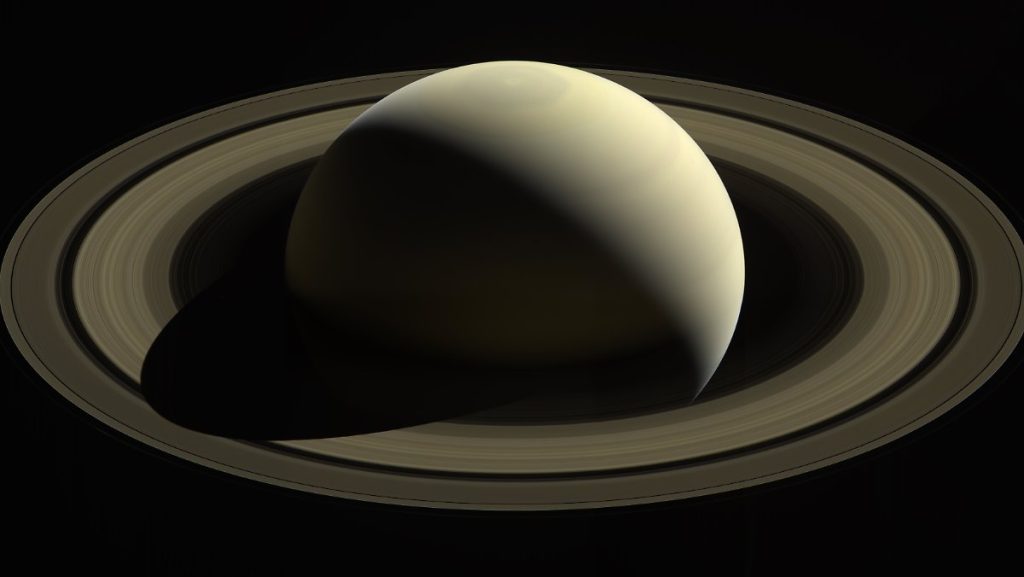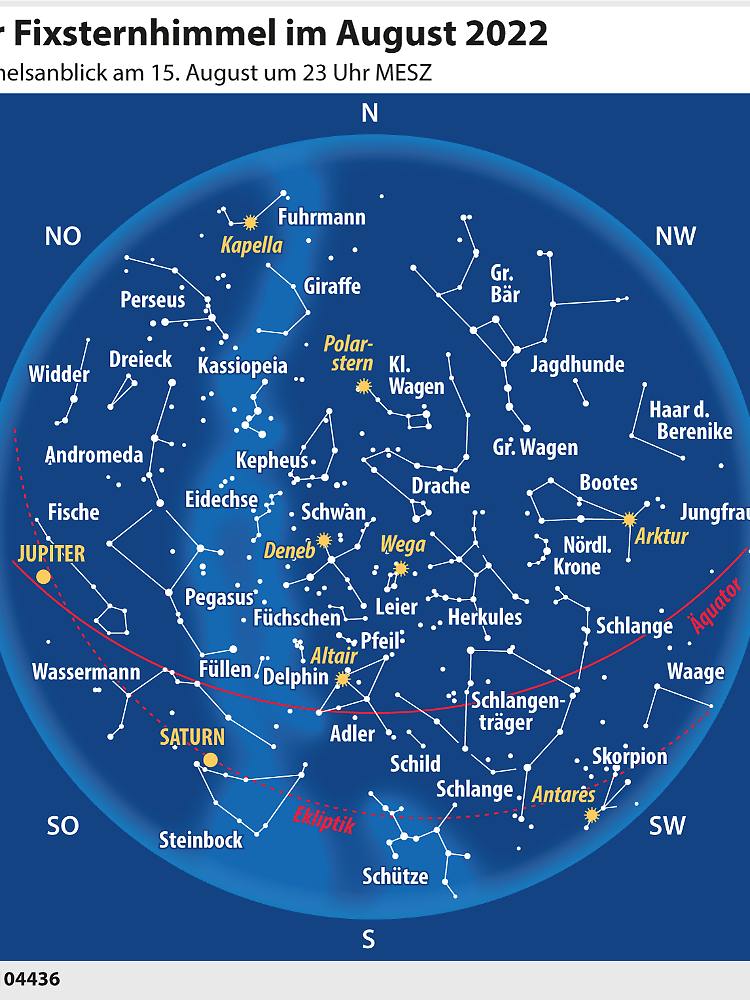The moon can disrupt the Perseids
Saturn is especially close in August
7/31/2022 2:26 PM
August offers star lovers a particularly good opportunity to enjoy Saturn. It is relatively close to Earth. Of course, Star Month also offers a beautiful celestial spectacle—but this year, with one limitation.
At the beginning of August, the waxing crescent moon is already visible at dusk. You can still notice the ash gray moonlight appearing. The crescent moon reflects sunlight. But even the part of the moon that is not illuminated by the sun is not completely dark, but rather pale. It is the reflected light of the earth. Because around the time of the new moon, the Earth appears to be almost fully lit as seen from the moon. For astronauts on the Moon, the full Earth phase will appear.
From day to day, the crescent moon becomes thicker, until the moon finally lights its half on the fifth. The full moon occurs at 3:36 am on the 12th. Barely two days ago, the moon came close to the Earth, only 359,828 kilometers separates it from us, while remaining 405,418 kilometers away on the 22nd.
Slightly north, that is, above the full moon, Saturn shines, which is exactly opposite the Sun on the fourteenth day. Like a full moon, Saturn can be seen throughout the night. Both stars rise in the east when the sun sinks below the horizon in the west, reach their highest position in the south at midnight and set in the west in the morning. Since the Moon and Saturn correspond to the Sun as seen from the Earth, one speaks of the position of opposition or simply of opposition to the Sun.
Saturn “only” 1325 million km
It is now especially convenient to observe the ringed planet, because it is “only” 1325 million km from Earth. This corresponds to nearly nine times the distance between the Earth and the Sun. Light travels this distance in an hour and 14 minutes. Saturn is the second largest planet in our solar system. Its diameter is ten times larger than the diameter of the Earth. As a result of its rapid rotation, Saturn is severely flattened. A Saturn’s day lasts only ten and a half hours.
Saturn’s remarkable ring system cannot be seen with the naked eye. It was discovered only after the invention of the telescope at the beginning of the 17th century. For those who have not seen the rings of Saturn with their own eyes, this is a great opportunity to observe the ring system. You need a telescope with at least 30x magnification. It is also worth visiting the observatory to see the ring of Saturn.
Images from space probes show that Saturn’s ring is made up of hundreds of individual rings. It consists of billions and billions of pieces of ice from the size of a speck of dust to the size of a house, orbiting around the ball of Saturn. Some ice particles fall on the surface of Saturn. In about 100 million years there will be no more rings of Saturn. Saturn is the planet farthest from the sun that can still be seen with the naked eye. The ringed planet has been on its way for nearly 30 years to orbit the sun once. People rarely live more than three years from Saturn. Titan, the largest of Saturn’s moons, can be seen with binoculars.
Jupiter lights up all night long
After the full moon phase, our moon changes to the second half of the night. You will search for him in vain in the evening sky. One day after the full moon, the Earth’s satellite meets the giant planet Jupiter. Jupiter gradually turns into a planet throughout the night and attracts attention with its brilliance. Before Venus appears in the morning sky, Jupiter is the brightest star in the night sky—aside from the Moon, of course.
On the nineteenth of the month, the waning moon meets our neighboring planet Mars with a reddish-yellow color, which is also represented in the sky in the second half of the night. The brightness of the swamps increases sharply in August. At the end of the month, Mars rises a quarter of an hour after 11 p.m. Finally, on the 27th at 10:17 AM, the new moon phase occurs.
A meteor shines in front of the Milky Way in the sky above Walchen Lake.
(Photo: Photo Alliance / dpa)
August is widely known as the shooting star month. It owes its reputation to the Perseid meteor shower, which is expected to reach its peak between August 9 and 13. Bright meteors, the so-called bolides or fireballs, are not uncommon. The peak of shooting star activity is expected on the night of 12 to 13, with up to a hundred meteors expected. This year, however, bright moonlight disturbs the notes.
The best time to watch is from 11 pm to 4 am. Perseid Stream meteors are fast-moving objects. It penetrates the Earth’s atmosphere at a speed of 60 kilometers per second, which is equivalent to 216,000 kilometers per hour. Perseids are caused by a cloud of debris from Comet 109P/Swift-Tuttle, which encounters Earth every year as it orbits the sun.
Summer triangle, swan and dolphin
The sparkling strip of the summer Milky Way stretches high across the sky. To see it you need a dark night sky. The delicately glowing band of the Milky Way, made up of thousands upon thousands of twinkling stars, is a natural phenomenon rarely seen by one in our time.
The Summer Triangle is now high in the south at the evening watch. Vega is almost at the height of the ukulele. Next to the harp, the swan spreads its wings. It features a large cross of stars known as the Northern Cross. Its main star is called Deneb. The third star in the summer triangle is Atair in the Eagle, 16 light-years from our sun. A little east of the swan is a small but recognizable dolphin image. Square of Pegasus slowly rises in the eastern sky. Pegasus is the guiding star of the autumn sky. In the northeast, Cassiopeia, Celestial W, is slowly gaining altitude.
The sun moves along the descending branch of its annual path. On the morning of the eleventh day, I left the constellation Cancer and moved into Leo. On the same day, Virgo entered the constellation Virgo early in the morning. The noon sun will decrease by just over nine degrees, and the length of the day will decrease by one hour and 51 minutes at 50 degrees north.

“Tv expert. Hardcore creator. Extreme music fan. Lifelong twitter geek. Certified travel enthusiast. Baconaholic. Pop culture nerd. Reader. Freelance student.”








More Stories
Space in City Hall has become more expensive
7 tips on how to learn to deal with your fears
“The kind of stone we were hoping to find.”